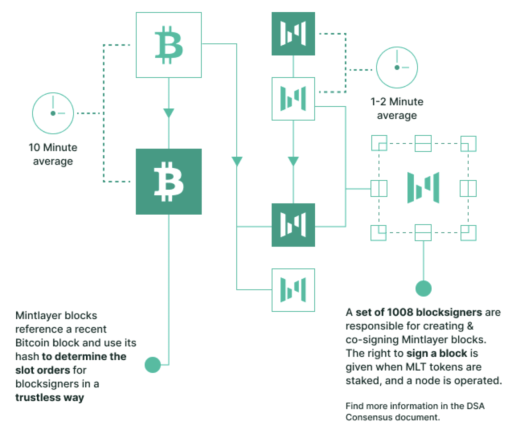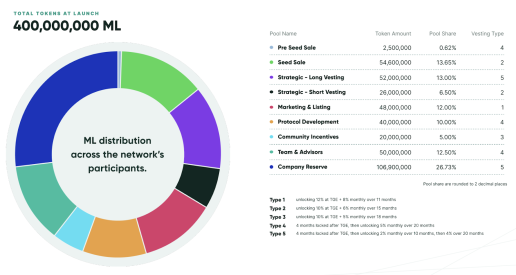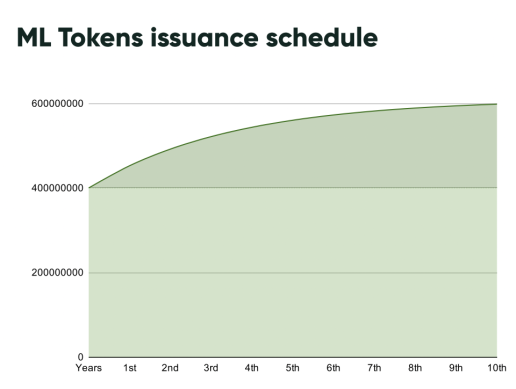Disclaimer: Content about scaling solutions and projects is not an endorsement. All content is solely for educational purposes.
A new Bitcoin scaling solution is being developed and is slated to launch on mainnet in Q4 2023. It comes at a time when renewed discussions around Bitcoin scaling followed the advent of Bitcoin Ordinals and BRC-20s earlier this year, along with a new layer 2 protocol known as Ark.
We will discuss this new scaling solution, its architecture, and some features that differentiate it from the rest.
The Mintlayer Stated Mission: Improving DeFi on Bitcoin with Smart Contracts
Mintlayer is a Proof-of-Stake (PoS) Layer-2 protocol bringing smart contract programmability to the Bitcoin blockchain. This new layer is designed to address Bitcoin's scalability issues and improve functionality by enhancing decentralized finance (DeFi) applications, decentralized exchanges (DEXes), stablecoins, and tokenization on the Bitcoin network.
Mintlayer functions as its own blockchain where transactions from every Mintlayer block are anchored to a Bitcoin block.
How Does Mintlayer Work? The Mintlayer Ecosystem
The Mintlayer blockchain is designed to be anchored to Bitcoin. It features a unique consensus called Dynamic Slot Allotment (DSA), which relies on the Bitcoin blockchain for security and participant selection. It is a refined version of PoS that incentivizes network validators with block rewards and disincentivizes malicious network behavior.
To begin, the Mintlayer protocol boasts its own consensus mechanism. A big part of understanding how Mintlayer works involves understanding how this consensus mechanism functions and what it offers.
Network Participation
Users who want to participate in consensus must stake at least 0.01% of the total token supply (e.g., 40,000 ML tokens). The minimum threshold allows stakers to be selected by the Mintlayers' algorithm. In addition to meeting the minimum requirement, users must also stake tokens for two rounds before the desired participation round.
This three-round lockup period, which lasts approximately three weeks, is meant to discourage malicious behavior as significant stakeholders have their tokens locked for a considerable time.
Consensus participants can choose to renew their lock-in, allowing them to participate in continuous rounds without dealing with the initial two-round lockup. Additionally, each participant can occupy multiple slots among the 1,008 available member slots.
Mintlayer uses a specific approach in which every Mintlayer block references a Bitcoin block. During each Mintlayer round, which lasts 1,008 Bitcoin blocks (~1 week), participants are selected from among stakers to contribute to creating new Mintlayer blocks. These eligible participants run nodes and stake enough ML tokens to meet a minimum staking threshold. Nodes that have a more significant number of tokens staked have increased odds of being selected.
The selection mechanism is powered by an algorithm that uses the hashes of Bitcoin blocks as a source of randomness to unbiasedly select participants and determine the order in which they will create and validate blocks. Participants who are chosen are then requested to build and propagate a block and collect all transaction fees at a given time.
Mintlayer also utilizes a checkpoint system that adds to the long-term security of the Bitcoin blockchain by ensuring:
- Prevent long-range attacks
- Allows nodes running fast-sync mode to download data from the last checkpoint
- To prune the blockchain before a specific block height to minimize data storage
Mintlayer network participants can create a checkpoint or a "marker" on the Bitcoin blockchain using the OP_RETURN function. This checkpoint can then be enforced by network nodes once enough Mintlayer blocks have been validated on top of that checkpoint. As a result of validated checkpoints, nodes running in fast-sync mode no longer need to download the entire blockchain and can download the blockchain from the latest checkpoint instead.

Source: Mintlayer Whitepaper
Block Propagation
Block proposers benefit from Mintlayer’s dynamic block generation feature, giving proposers a window of 1 to 2 minutes in which they're likely to have their block countersigned. This gives block proposers flexibility as they wait for the Mintlayer mempool to fill with transactions before creating and broadcasting a new block, as this can maximize their fee collection.
Sustainability and inclusivity are strong considerations in Mintlayer's design, with the block size limit set to 1 MB, ensuring the yearly blockchain size does not exceed 525 GB, even at peak block frequency.
Mintlayer Token Standards
The Mintlayer (ML) token is primarily used to participate in the networks' PoS consensus mechanism, governance and to pay transaction fees. However, there are three different ML token standards.
MLS-01
The MLS-01 standard allows transferring tokens and ML exclusively on the Mintlayer sidechain, preventing Bitcoin blockchain congestion. A key feature of MLS-01 is the ability to implement Access-Control-List (ACL) conditions, akin to the functionalities seen in Ethereum's ERC-20. ACL offers transaction customizability, facilitating token issuance or updating compliance features of security tokens to adhere to company policies or legal requirements.
Additionally, they allow for conditions on utility token expenditure, token non-fungibility, transaction thresholds, and time locks. Token issuers can update token conditions with a new transaction containing the revised rules. ACL governance flexibility depends on the original ruleset from token creation.
MLS-02
The MLS-02 standard features Bulletproof Confidential Transactions with Ring Signatures, guaranteeing privacy and anonymity. These privacy features increase the transaction's data requirement and add additional verification steps. As a result, MLS-02 does not benefit from transaction batching like MLS-01 does, resulting in higher transaction fees.
MLS-03
The MLS-03 standard is Mintlayer’s iteration of non-fungible tokens (NFTs).
Token Supply
At Mintlayer’s Token Generation Event (TGE), 400,000,000 ML (~67% of total supply) tokens were pre-mined. Although the vast majority of these tokens at launch are locked and subject to a vesting schedule, 15,820,000 ML tokens, approximately 2.6% of the circulating supply, were immediately unlocked at TGE. A brief breakdown of tokens unlocked at TGE is below:
- Seed Sale: 5,460,000 ML Tokens (10% of allocation)
- Strategic - Short Vesting: 2,600,000 ML Tokens (10% of allocation)
- Market & Listing: 5,760,000 ML Tokens (12% of allocation)
- Community Incentives: 2,000,000 ML Tokens (10% of allocation)
After two years, approximately 335,000,000 ML tokens, or about 56% of the total supply, will be unlocked.

Source: Mintlayer
The remaining 200,000,000 ML tokens will be distributed via block rewards to network validators during the first 10 years following the mainnet launch until reaching the 600,000,000 ML hard cap. Once the supply cap is reached, the network will transition to a 100% fee-based system.

Source: ML Lightpaper
Mintlayer has a dynamic issuance schedule where block rewards decrease by 25% yearly until 200,000,000 ML tokens are generated. Block reward distributions in the first and second years comprise 100 million and 75 million ML tokens, respectively. Notably, within the first three years of the mainnet launch, nearly ~97% of the total block rewards allocation will be distributed. This distribution schedule implies that a robust fee market is anticipated to quickly replace block reward subsidies to continue incentivizing network participants.
What Makes Mintlayer Different?
Mintlayer uses the WebAssembly Virtual Machine (WASM) to execute Script Hash (e.g., Bitcoin-like script-based), a Turing-incomplete programming language. Script Hash combines features like multi-signature accounts and hashed time lock contracts (HTLC) to create more sophisticated contracts while maintaining reliability, predictability, and efficiency.
This architecture allows users to switch between UTXO and account-based systems with programmable pools. Despite Mintlayer's smart contract functionality being Turing-incomplete by default, a Mintlayer token can be burned in exchange for a Turing-complete token. These programmable tokens enable a more flexible execution environment and allow users to revert by burning the newly minted token.
Mintlayer's Access Control List (ACL) allows for restrictions on specific cryptocurrency transactions to maintain legal or policy compliance. These rules can be dynamically updated by token issuers on MLS-01 tokens via new transactions.
Users can benefit from lower fees and improved transaction throughput with Mintlayer's transaction batching (e.g., UTXO model) and Lightning Network integration. Although, by default, fees are paid in ML tokens, users can pay in any MLS-01 token accepted by a block signer.
Is Mintlayer a Layer-2 or Sidechain?
There has been some confusion as to whether Mintlayer is an L2 solution for Bitcoin or if Mintlayer is a sidechain. A brief breakdown below on Layer-2s and sidechains will help determine where Mintlayer falls between the two.
An L2 blockchain:
- Runs in parallel with a primary blockchain (e.g., Bitcoin)
- Can bring transactions off-chain to improve transaction efficiency (e.g., Lightning Network)
- Utilizes the security and decentralization of the primary blockchain
Whereas a sidechain usually possesses these qualities:
- Is an independent blockchain linked to a primary blockchain
- Hosts its own rules, security properties, and consensus (e.g., PoS)
- Utilizes checkpoint systems for validators to refer back to its previous state
- Ability to bridge native asset from primary blockchain to sidechain
When isolating Mintlayer’s native features, it functions as a sidechain due to having its own independent blockchain, PoS consensus, checkpointing system, and ability to peg native BTC into a wrapped Bitcoin equivalent using its MLS-01 or MLS-02 token standard.
However, Mintlayer inherits L2 functionality due to its Lightning Network integration enabling users to benefit from off-chain transaction efficiency using BTC, ML, or MLS-01 tokens.
Since Mintlayer’s characteristics straddle both a Sidechain and L2, it appears best to classify it as a hybrid Layer-2 sidechain.
The Emergence of a New Bitcoin Layer
During a year of renewed excitement around the Bitcoin and crypto ecosystem, it's inspiring to see builders developing new scaling solutions and bringing additional tools, applications, and use cases.
Mintlayer is worth keeping on the radar as Bitcoin's suite of scaling solutions grows, and as more people explore the Bitcoin ecosystem and expand the blockchain's capabilities.

